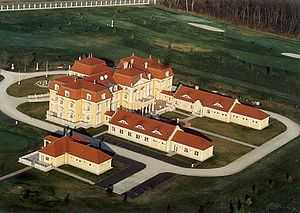Dunakiliti
| Dunakiliti | |
|---|---|
 Dunakiliti | |
| Coordinates: 47°57′54″N 17°17′19″E / 47.96513°N 17.28853°ECoordinates: 47°57′54″N 17°17′19″E / 47.96513°N 17.28853°E | |
| Country |
|
| County | Győr-Moson-Sopron |
| Area | |
| • Total | 33.66 km2 (13.00 sq mi) |
| Population (2004) | |
| • Total | 1,800 |
| • Density | 53.47/km2 (138.5/sq mi) |
| Time zone | CET (UTC+1) |
| • Summer (DST) | CEST (UTC+2) |
| Postal code | 9225 |
| Area code(s) | 96 |
Dunakiliti is a village of about 2000 people in the Győr-Moson-Sopron county of Hungary.
Church
Dunakiliti is centered around its Roman Catholic church, which was built in 1910 in a Neo Gothic style. An older church was built in the same spot in 1735 in a Baroque style. Before the earlier church there was a small round singular room church in the same spot as well. On March 1, 1910 a base was added to the church in a way allowing the original church to stand, while construction began on the newest one. A month later the church from 1735 was deconstructed. While breaking down the church several skeletons were found, causing many to believe that the church served as a cemetery in its first few years. On September 25 of 1910 the first mass was celebrated in the new, but unfurnished, church. In 2010 the church celebrated its 100 year anniversary since its last major redesign. The village was given a grant to beautify the surrounding areas, in honor of the 100 year anniversary.
Location
Dunakiliti is a village in Győr-Moson-Sopron county, Hungary. It is in a region commonly referred to as the Little Hungarian Plain. Dunakiliti is located near both the Slovakian and Austrian borders. Dunakiliti is located approximately seven kilometers from the Slovakian border and 20 kilometers from the Austrian border. Additionally, the Slovakian capital of Bratislava is approximately 15 kilometers away from Dunakiliti as well.
Population
According to the 2011 census, Dunakiliti's population was approximately 1,987, and has been growing for decades. Population has increased, and continues to, partly because of a large number of commuters from Bratislava who buy or build there houses in Dunakiliti but go to Bratislava to work. Due to this, the village has a mostly Magyar, and secondly Slovak population.
Early History
A chapel in the village dates back to the year 1562, which is the same year that the Dunakiliti Roman Catholic Parish was formed.

External links
- Street map (Hungarian)